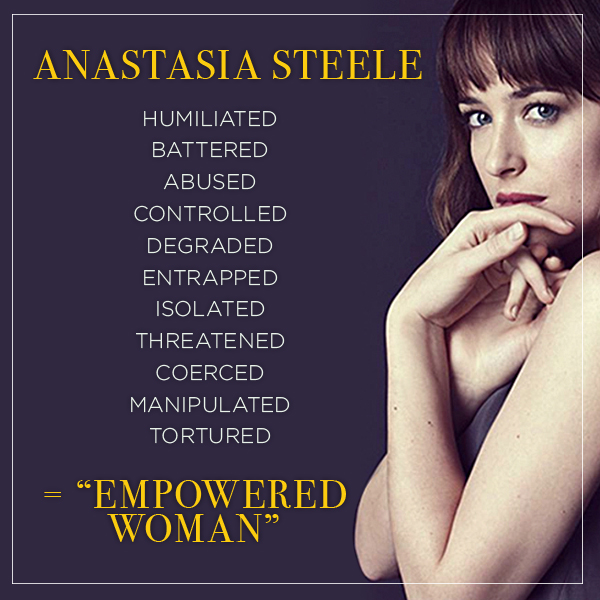50 Shades? The Neurological Consequences of Sadomasochism
 Public Discourse 17 February 2015
Public Discourse 17 February 2015
Another strange sign of our age appeared more recently, with the enormous popularity of Fifty Shades of Grey, which has sold an astonishing 100 million copies, and set a record in the UK as the fastest-selling paperback of all time. The story depicts a young female ingénue who is gradually initiated by a wealthy and powerful man into a BDSM sexual arrangement—Bondage, Discipline, Dominance, Submission, Sadism and Masochism— in which she acts as his “submissive.” The heavily marketed movie version of 50 Shades of Grey was released on Valentine’s Day, raking in $94 million over its opening weekend.
Tom Wolfe’s observations suggest that the random impersonal sexual encounter is a defining feature of our day and age. Likewise, the enormous popularity of Fifty Shades suggests that interest in the world of BDSM may be another. What should we make of this? Is there any cause for concern here?
Fifty Shades: A Model of Abuse
My purpose here is not to examine the literary merit of Fifty Shades of Grey (or the lack thereof). Instead, I’m going to examine the phenomenon of BDSM from the perspective of a psychiatrist.
In 2013, social scientist Amy Bonomi of Michigan State University published an interesting study titled “‘Double crap!’ abuse and harmed identity in Fifty Shades of Grey.” In this study, the relationship depicted in the story was assessed for characteristics of “intimate partner violence,” using widely accepted standards from the CDC for emotional abuse and sexual violence.
This study found that nearly every interaction between the male and female protagonists in the book, Christian and Anastasia, was emotionally abusive. Their relationship includes typical features of abusive relationships, such as stalking, intimidation, and isolation. In fact, the book’s pervasive sexual violence meets the CDC’s definition of sexual abuse—including Christian’s use of alcohol to overcome Ana’s reluctance to consent. The researchers also found that Ana exhibited classic signs of an abused woman, including the sense of a constant perceived threat, stressful coping styles, and an altered sense of identity.
A second study published in 2014 by the same author looked at 650 women aged 18-24; it found that the women who had read the book were more likely than those who had not read the book to exhibit signs of eating disorders and have a verbally abusive partner. Women who read all three books in the Fifty Shades trilogy were found to be at increased risk of engaging in binge drinking and having multiple sex partners—known risks associated with being in an abusive relationship.
There are limitations to this study: it did not distinguish whether women experienced the health behaviors before or after reading the books, so we cannot say whether the book contributed to these behavioral problems. It’s entirely possible that some women were more drawn to the book because they struggled with these behavioral issues already. But Bonomi argues that the findings are problematic either way. As she explains it:
If women experienced adverse health behaviors such as disordered eating first, reading ‘Fifty Shades’ might reaffirm those experiences and potentially aggravate related trauma. Likewise, if they read ‘Fifty Shades’ before experiencing the health behaviors seen in our study, it’s possible the books influenced the onset of these behaviors.
The Problem of Consent
Those who defend BDSM, like those who defend the campus hook-up scene, usually rest their case on one element and one element alone. That element is not love. That element is not fidelity. That element is not commitment. It’s not even pleasure.
That element is consent.
This one feature is seen as all-important and decisive. On this social contract model, as long as both partners consent, then everything is okay. As long as both partners consent, no one is harmed in the process. In Fifty Shades, although Ana is ambivalent and reluctant—it takes her a while to warm up to the BDSM arrangement—she eventually consents to the masochistic/submissive role. Well, then, no harm, no foul. Right?
Wrong.
First, people often consent to things that they are not really comfortable with; they do so for many different reasons and under many different social pressures. We see this clearly in Ana’s reluctance to sign Christian’s contract. Second, people often consent to things that turn out to be quite harmful to them. For consent to be authentic consent, it must be truly informed. To consent, people must understand the risks of what they are agreeing to do. This is a basic tenet of medical ethics, and it applies here as well.
I recall one patient I treated, a young man who was one of the smartest people I’ve ever met. He was in a committed relationship with a similarly brilliant but troubled young woman. She wanted him to hit her during sex. He consented . . . sort of. That is, he agreed, and he did it, but he never really liked it. He was always reluctant. It troubled him, and eventually it got in the way of things. The relationship, as you might expect, eventually fell apart.
http://www.thepublicdiscourse.com/2015/02/14470/?utm_source=The+Witherspoon+Institute&utm_campaign=a2e410a62d-RSS_EMAIL_CAMPAIGN&utm_medium=email&utm_term=0_15ce6af37b-a2e410a62d-84094405






